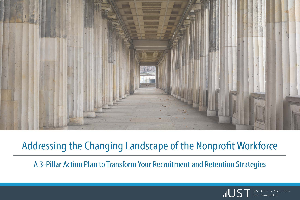
While many foundations are well on their way with going mobile, start-ups and smaller organizations may still be trying to figure out how to establish a mobile presence in addition to their website and email operations. There are important matters to consider, the first of which is to determine what is considered a mobile device.
GFC Global describes a mobile device as “a general term for any type of handheld computer. These devices are designed to be extremely portable, and they can often fit in your hand. Some mobile devices—like tablets, e-readers, and smartphones—are powerful enough to do many of the things you do with a desktop or laptop computer.” Mobile devices run on mobile operating systems—the two major operating systems are Android and iOS.
Most nonprofits have a website that interacts with and receive donations from other PCs. Many have a Facebook or Twitter account to announce events and direct visitors to the main website for more information and to donate to their cause.
Not all institutions dedicated to good works have adapted their internet sites to interact with mobile devices or optimized those sites so that they can at least be viewed on mobile devices. Increasing numbers of nonprofits are catching on to the benefits of connectivity with mobile devices but before examining the pros and cons of transitioning, here are some compelling statistics about mobile device use.
First is a demographic shift in smartphone ownership in this survey report from the Pew Research Center (1/13/2022) by Michelle Faverio. “The (2021) survey found that 96% of those ages 18 to 29 own a smartphone compared with 61% of those 65 and older, a 35-percentage point difference. However, that gap has decreased from 53 points in 2012. The survey also showed that 95% of those ages 30 to 49 reported owning a smartphone in 2021 and 83% of those 50 to 64 said the same.” Going mobile is not just for Gen X, Millennials, and Gen Y.
In his article forthe site Exploding Topics, Internet Traffic from Mobile Devices(2/7/23),Josh Howarth affirmed, “Internet use and mobile use are components of everyday life for billions of people. In fact, for many, the two now go hand in hand.” What follows are selections from his breakdown of “the current state of mobile devices in 2023.”
Howarth maintained that “e-commerce is among the most popular (use) for mobile devices. Indeed, more than half of the online population (55.4%) are likely to have bought something online in the past month with their mobile device.” It is into this larger e-commerce category that charitable donations would fall.
Looking forward, he concluded, “There are 4.66 billion active internet users. And 4.32 billion active mobile internet users. Notably, those figures are almost identical. The discrepancy between active social media users (4.2 billion) and active mobile social media users (4.15 billion) is even smaller.”
Howarth paints a dynamic vision of the future for nonprofits deciding to go mobile. Let’s examine both the pros and the cons for foundations that haven’t stepped onto the fast track yet.
Marita Meegan, writing for fundaisingIP.com, wants you to pause and consider Is Your Website Optimized for Mobile Devices? She recommends that you learn how many people visit your site from mobile devices. If you don’t have an analytics program on your site, she recommends Google Analytics, which is free to download and use. With Google Analytics or your own program, you can determine how many people drive by your site and the make and model of their internet jalopy.
She also encourages you to look at how your site appears on the variety of mobile screens types out there. Larger tablets will probably display your site correctly, but smaller tablets and smartphones will not reflect the site’s optimal appearance and will require design modifications to accommodate the different types of screen sizes that your analytics reveal. Observe how well your site functions on those screens, especially the donation pages.
She offers useful tips to pare your site down for optimal appeal and usability on smaller screens. A simple design that functions well with easy navigation will make the mobile version of your site more user-friendly and seem more trustworthy.
Ms. Meegan ventures into the pro and con territory when she asks Should Your Non-Profit Have a Mobile App? On the pro side are variety, flexibility, and apps tailored to your organization’s needs and specialization. There are apps for all kinds of digital appetites, ranging from Red Cross emergency tips to a geo locator for fundraising events, not to mention apps for donation and check out. You determine what you need at the outset and what you can do without for now because big apps can cost significant money. An app, she cautions, will continually incur costs for your nonprofit. Software requires upgrading each time something changes on a device’s operating system. Updating your app can be costly: security updates, data protection, bug fixes, upgrades and more—and for each platform you design it for. Again, a careful study of your analytics will help you determine which platforms and apps can get you the best mileage to see a ROI. She suggests third-party apps might meet your budget needs.
As it should be obvious by now that going mobile is the way everything is going, PRO and CON might best be reframed as PROPOSAL and CONSIDER. Best-selling finance author Robert Kiyosaki teaches that we should never say to ourselves, “I can’t afford it” when presented with an opportunity, but that we should instead ask ourselves “How can I afford it?” So, stepping outside the PRO and CON box and into a space of Proposal and Consider, we can weigh some of the more widely expressed concerns about going mobile.
| PROPOSAL | CONSIDER |
| Mobile apps are difficult to manage. | Mobile apps streamline daily operations, automate tasks, and integrate them on one platform, saving time and resources. |
| Texting is laborious and a time suck. | Mobile texting can reach large numbers of people in a blink of time. Templates can help. |
| How is text-to-give secure? | Text-to-give forms protect transactions and donor data. |
| Getting someone to create new apps can be expensive. | Third-party companies like AppMySite provide a user-friendly, DIY, no-code,mobile app builder that makes creating premium native mobile apps accessible for nonprofits.These apps you can build in minutes to work with Android and iOS. It costs less than an in-house app designer, but it also gets you started for free. |
| Nonprofits think their donor base is older and won’t use smart phones. | Mobile users span multiple generations. There is no digital divide here, only growing numbers of mobile users of all ages. |
| Managing volunteers with a mobile device sounds like herding cats. | A volunteer mobile app reduces the volunteer management process with self-serve features to enhance communication, recruitment, training, more. |
| How can you raise funds with a simple, plain text message? | Ask candidates and staff from last year’s midterm elections how they raised funds in minutes with a simple text-to-give alert versus direct mail or email. |
| Has text-to-give been around long enough to demonstrate its usefulness? |
Donation via text has been part of disaster response since Hurricane Katrina in 2005. But text-to-give really took off after the 2010 Haiti earthquake, when the American Red Cross raised more than $32 million within one year. It was also around for the first Ice Bucket Challenge, and that Challenge went from viral to phenomenal. |
A final thought about going mobile. Ask yourself, “How can mobile technology connect with my mission and connect my mission to others?” The answer may sound like a good song about a car.
This blog post was written by Amélie Frank, consulting copywriter to UST. To learn more about Amélie’s professional portfolio you can find her online at https://www.linkedin.com/in/amelie-frank/

It took a man of vision, optimism, and great will to lead the United States out of the Great Depression and through World War II. Yet, his greatest struggle was a private one, a battle he would win for all of us. In 1921, Franklin Delano Roosevelt contracted poliomyelitis-also known as Polio. Polio was a highly contagious virus that attacked the central nervous system, withering and paralyzing muscles-killing many by robbing them of the ability to breathe.
After being elected governor of New York, President Roosevelt declared a new war—one against polio. He founded the nonprofit National Foundation for Infantile Paralysis. Popular film and radio star Eddie Cantor dubbed the effort “The March of Dimes” and urged Americans to act, stating, “The March of Dimes will enable all persons, even the children, to show our President that they are with him in this battle against this disease. Nearly everyone can send in a dime, or several dimes.” Over 80,000 letters filled with dimes, quarters, and dollars created a “silver tide which swamped the White House,” totaling $268,000. The March of Dimes carries on to this day.
Today, a dime seems a flimsy means to ignite a fundraiser. A candy bar worth a dime long ago now runs about $2.39. Still, consider the fact that if you were to take an empty two-liter plastic soda bottle and fill it with dimes, you’d have about $700 in donations. Now, what if you put ten of those bottles out in the right places for interested people to fill? That is what The March of Dimes did with their donation cards placed at cash registers everywhere. That is what the Ronald McDonald House does with its collection bins built right underneath the drive-thru window.
New and small nonprofits often have few assets beyond the skills and passion of their founders and volunteers. They may not have the equipment, a regular venue, a budget for props, rental equipment, food, entertainment, video systems, or fabulous prizes but the one thing they do have is determination. Following are some popular types of inexpensive fundraisers, some of which don’t even cost a dime!
Affiliate Fundraisers
Affiliate fundraisers generate passive income through event-free fundraising. It’s all handled online. Simply partner with an online shopping program affiliated with retailers that are popular with your supporters and then ask your supporters to make purchases through the program’s app or browser extension. All contributions will come from the retailers, while your supporters do nothing but make regular purchases, taking advantage of the same sales and coupons they normally do. It costs them nothing extra. Amazon is a great place to start since 100,000’s of people shop the site daily.
Kroger, America’s largest grocery chain, offers a community rewards program that you can join for free as an individual shopper. All you have to do is register your nonprofit. Theneach time your supporters swipe their rewards card at a local Kroger (their stores are everywhere under many different names), your nonprofit gets a percentage of the sale, which is paid out quarterly. It should be fairly simple to persuade your team, your supporters, your friends, and your family to link their rewards cards with your nonprofit. For more information, click here.
Other companies that offer Affiliate programs include ShopRaise and Fundraising.com. Beginning this year, Amazon has discontinued its AmazonSmile Program.
Charity Navigator suggests doing your homework to find the right affiliate program for your nonprofit. Most can get started in three steps:
Bake Sales
Forever popular, bake sales enjoy good ROI because members and supporters supply the goodies. Ask participants to donate their best baked goods (preferably pre-wrapped for sale). Stake out a location or event with good foot-traffic to hold the sale. Pastry sales do especially well around breakfast time.
Cook-Offs
There are so many great eats to put in contention: pie, chili, BBQ, cookies, tacos, cake, preserves, and more! Invite everyone to enter their fabulous dishes (in very large qualities) in a cook-off event for top honors. Charge participants a fee to sample and vote on the best dishes. The biggest challenge with a cook-off is advertising and luring chefs to participate. You can put a fork in both problems by offering the contestants an advertising opportunity where you can promote them heavily as part of the event.
Google Ad Grants
Google helps nonprofits raise the visibility of their high-value pages through itsGoogle Ad Grants program. They’ll reward your organization with up to $10,000 in ad credits each month when you apply and get approved. You can use those credits to get ad space on search results pages for the most vital keywords for your mission. Additionally, you can . . .
There are some eligibility criteria your organization must meet to become, then stay eligible. You must also research keywords to connect you with the right prospects. If you want to make the most of your Google Grant money, you might outsource the work to a Google Grants agency, which handles everything including the initial application, keyword research, and account reactivation.
Matching Gift Drives
Matching gifts are a part of many corporate philanthropy practices. Anyone who works for a major corporation, likely offer this as an employee perk. Through these programs, companies will match a portion (usually 50% or more) of the donations their employees give to nonprofits. It’s smart to partner with a matching gift database provider (such as Double the Donation) to help supporters find their matching gift opportunities.
Coin Challenges
The March of Dimes began as a coin challenge. Coin Challenges can also be fun. They cost next to nothing to set up, and if today’s coin shortage remains an issue, paper currency is just as good.
One of the cutest is Make-a-Snake, great for school or the next reptile show. Encourage schools to form teams that will collect spare change from around their neighborhood by going door to door with an adult. On the designated day, children bring the cash to the collection event. Then, each team of kids constructs a “snake” with their dollars and coins. The group creating the longest snake wins!
Collection jars or bottles branded for your nonprofit can be left with friendly businesses to encourage donations at check-out. Schools have issued coin challenges for a variety of charities, often times competing against other schools in the area. Continual updates on social media can keep the fire burning under this contest to the very end.
Timed Campaigns
You can turn your fundraiser into an episode of “24.” Day-long fundraising campaigns, AKA giving days, tend to bring in substantial revenue despite the short timeframe. By sustaining urgency through social media and other announcements, supporters are likely to be inspired to donate. Give the challenge a popular TV or movie action theme to add to the fun. It pays to be suspenseful, whether you do it in the hallways of your high school or online with a web page or app that ticks down the seconds.
Polar Plunge
For the brave and daring, nothing beats a dip in freezing water. How long can you hold out? You and your supporters can take pledges linked to endurance and then during the event, you’ll plunge into the icy water and complete to the be last one out. The longer you stay in, the more money you raise from pledges.
To encourage participation, ask local vendors to provide necessities such as towels, blankets, warm drinks like hot chocolate or cider, hand warmers in exchange for sponsorship promotion and bragging rights. Also, don’t forget waivers for your participants to sign. For the best results, host your Polar Plunge around the holidays. Each year, this unique fundraiser can draw a larger, more festive crowd. Be sure to leave out donation boxes for thrill-seeking onlookers to put in their two dimes.
These are but a handful of many inspired ideas for fundraising on a dime and we hope you are finding some inspiration for your future fundraising efforts.
This blog post was written by Amélie Frank, consulting copywriter to UST. To learn more about Amélie’s professional portfolio you can find her online at https://www.linkedin.com/in/amelie-frank/

Voluntary turnover harms your bottom line. Your team must focus on providing meaningful work, goal-setting, and communicating that you value their worth. Please note: Masking difficult work conditions with “fun” items like free beverages will not build the employee engagement necessary to break many organizations’ cycle of preventable terminations.
Consider the following sensible suggestions to help your team reduce employee turnover:
Know Your Stuff with Workforce Analytics
You might notice your managers losing employees, but do you know which few are high on the retention scale? Take care to standardize your metrics across the organization, using the same rules for all teams. Performance management software can help you track conversations and responses. Your job profiles will be more accurate, and you can set clear expectations of others. Keep everyone on the same page regarding meeting notes and performance evaluations. Determine which managers have markedly kept employees engaged, so you can set up a program allowing them to teach those skills to other managers.
Make the Most of Personalities
Teams excel when a variety of key personality types are orchestrated. If you blend risk-takers with detail-oriented individuals, you’ll benefit from an innovative team that can finish projects. Too many of any one type of personality, and you risk losing innovation or failing to meet project completion deadlines. Blend these two with some people-oriented relationship builders to help everyone work together. When selecting personality assessment tools, choose one that is appropriate for the work environment, such as trengthsFinder, the DiSC assessment or the Core Values Index.
Find the Right People
It may seem like a lot of work to define skills, values, and personalities that work best for the roles you need to fill. And it’s even more work to confirm that your pay and benefits are within reasonable benchmarks for your region and industry. But hiring someone who stays for years will make it worthwhile.Repeatedly filling a slot with wrong-fit people will cost you money, time, and missed deadlines.
If an employee has been given ample time, onboarding, and additional training but just can’t finish projects or fit your values and culture, you need to let him go. Don’t give poor-fit workers the time to frustrate and drive away your productive staff members. The more you find right-fit employees, the less often you’ll be forced into one of these situations.
The Nonprofit Equation
In large part, people do not take employment at nonprofits for the money. They go into it to feel a strong sense of purpose. Just be aware that their initial interest does not solve employee turnover. People burn out. Lack of investment in a workplace infrastructure can leave staff overworked and underpaid—which will demolish employee engagement. Yet, for decades, the “low pay, make do, and do without” culture of the nonprofit sector has prevailed.
Shockingly, more than 80% of nonprofits have no formal retention strategy. They are not prepared to withstand the varied and tangled reasons for their high turnover. There are countless reasons why employees leave, including: low pay, no upward mobility, excessive workloads, lack of career development, missing mentors, lack of growth opportunities, no rewards or recognition, poor leadership, lack of organizational vision, stifled communication, challenging or even hostile culture, inadequate job reviews, long work hours with no flexibility. Nonprofit leaders simply accepted the resulting high turnover as the cost of doing business.
Before you lose another needed staff member, consider these steps to addressing the causes:
Support Their Talents, Capabilities, and Dreams
There is a delicate balance to consider when summing up each employee’s strengths. On the one hand, you don’t want to push your staff members to do things they’re not equipped to handle. For example, a sensitive introvert might not be the best choice to handle cold calling or outbound fundraising approaches. All those rejections might scare them right out of your organization. On the other hand, you must do your best to avoid unconscious bias in project assignments. If you think someone might be unable to handle technology because of their age, think again. The same goes for gender, race, country of origin, or any other unreliable indicator. An employee’s demonstrated strengths are very different from your assumption of an employee’s weaknesses based on gut feelings. So, as you get to know employees, follow their work, and talk with them about their career goals, your genuine knowledge of their talents, skills, interests, and career goals can help you guide them in directions where they will feel engaged and motivated to pursue excellence.
Counting the Cost of Turnover
If your nonprofit is struggling with loss of staff, especially as we climb out of the COVID-19 pandemic, developing a robust retention management plan can help. It’s worth your time to learn some metrics and calculations. If you’re not paying attention to your turnover metrics, you’re missing key information necessary for your nonprofit’s ongoing survival. These numbers will help you know with clarity and certainty how your organization is doing and where it needs help.
Metrics can lead you to ask questions and find out why particular people are leaving so you can formulate targeted retention strategies that work. In all, your retention management plan will empower you to determine the extent of your losses, diagnose exactly what’s causing the problem, and then develop strategies you can implement to improve your situation. Ensure your success with the following metrics:
The expense of replacing a single employee can be as high as 60% of her annual salary. Total costs go much higher. And these expenses are harder on smaller nonprofits. No matter how you feel about working with numbers, your organization is counting on you to intervene with crucial information. The numbers you generate will help you influence turnover rates and save your organization from painful costs.
Take the Turnover Tour
There are many reasons that employees leave a job. The first distinction, of course, is whether that turnover was voluntary or involuntary. They require different management techniques. First, be sure to handle the legal requirements for involuntary turnover as well as the root causes of such loss (such as an inadequate job description or depleted talent pool).
Next, pay attention to your voluntary turnover. Among workers who leave voluntarily, there are two types: Functional and Dysfunctional. Watch out for the latter. Functional turnover doesn’t generally hurt an organization, as you’re losing poor performers or easily replaced employees. Dysfunctional turnover, on the other hand, will hurt your nonprofit in many ways. You could lose your high-performers and employees with hard-to-replace skills. You also risk losing your diverse culture, as women and minority group members leave.
The final distinction separates two types of dysfunctional turnover: Unavoidable and Avoidable. If someone leaves to move out of state with their spouse, there will be little you can do to prevent it (though remote work is becoming a widespread new option). Generally, if there is nothing you can do to prevent the change, it’s unavoidable. Every employer will face a certain amount of this. Avoidable turnover is where you must focus. Find ways to improve employee satisfaction. And before you decide if a case of turnover is unavoidable, it might be time to consider how to change it. An employee who quit in the past to start a family may stay with you, now, if your organization starts offering paid maternity leave, on-site childcare, and other working-parent benefits. Some solid number crunching that compares the cost of replacing lost talent against the cost of keeping employees from leaving will help you determine your best case-by-case course of action.
Why They Leave
In considering why employees leave your organization, be sure to consider the following reasons they could be exiting your nonprofit:
• The job is unsatisfying. Your nonprofit has not been able to tip the scale of inducements over their Contributions. Look deeper at their desire to leave and ease of leaving.
• Something better became available. They may or may not be dissatisfied with their current job, but perhaps an even more appealing job was offered elsewhere.
• They’re following a plan. This could involve educational or family goals or some other life transitions that preclude their staying in the job. There will likely be little you can do about these departures unless remote work and flexible hours sweeten the inducements to stay on-staff.
• They’re leaving without a plan. This is an impulsive action. It might be their response to something negative happening at work, such as losing out on a promotion. If they’re leaving due to some preventable workplace experience, such as sexual harassment, you must find better ways to protect your employees.
Why They Stay
Employees who stay in one job for years usually find themselves embedded in their workplace, culture, and community. They’ve grown a thriving network of relationships and professional connections that fulfill both their professional and personal lives. When they leave a job, they often lose most of those long held ties. Here’s where you can support your embedded employees:
The Pandemic’s Influence
Even before the pandemic hit, approximately a quarter of American workers were quitting their jobs in order to find something better. With the economic recovery, many are now seeking to leave after the pandemic ends. Approximately 80% are concerned about career advancement, a common problem in the nonprofit sector. However, it’s even more important to note that 72% of American workers say the pandemic forced them to rethink their skill sets. More than half of those planning to leave their jobs spent the pandemic months training to build new skills. Many did so in preparation to change jobs within the next few months. The reality of moving from job to job to increase your pay and boost your career status reportedly works better for white males than for women or minorities. In fact, this kind of post-pandemic shift carries the potential to worsen income inequality and other inequities, as college educated white workers increase their remote-work options while other employees remain unable to job hop. Take these three steps to maximize employee retention in the post-pandemic economy:
This is an excerpt from UST’s eBook, “3 Essential Practices to Cultivate a Positive Employee Experience” in collaboration with Beth Black, Writer and Editor.

Question: Do we need to investigate rumors of harassment even if no one has made a complaint?
Answer: Yes, you should investigate. A company always has some inherent liability in relation to discriminatory or harassing comments or behavior. The level of liability usually correlates to the nature, severity, and context of the comments, the position of the employee who made them, and what the employer does or does not do about it.
Since you have knowledge of a potential situation, you should investigate the matter and take appropriate disciplinary action if it turns out your antiharassment policy was violated. As you conduct the investigation, document the discussions you have as well as your findings, and reassure those you interview their participation will not result in retaliation.
This Q&A was provided by Mineral, powering the UST HR Workplace. Have HR questions? Sign your nonprofit up for a FREE 60-day trial here. As a UST member, simply log into your Mineral portal to access live HR certified consultants, 300+ on-demand training courses, an extensive compliance library, and more.

It is nearly impossible to find data about compensation increases without inflation figuring in every discussion. In 2022, amidst the first global pandemic in over a century, the average price of gas skyrocketed to $5.75 per gallon (up from a low of $2.68 in May of 2020). The inflation rate for 2022 finished at 6.5%, and today (for the moment), gas prices sit as low as $3.49 in some areas. The federal minimum wage will increase to $9.50 per hour this year, varying significantly from state to state. You can visit The Horton Group page on minimum wages for the state-specific wage rates.
Investopedia.com defines inflation as “a rise in prices, which can be translated as the decline of purchasing power over time.” Among today’s inflationary pressures we can count damage to crops, livestock, lives, and property from recent climate change events, Russia’s invasion of Ukraine spiking the costs of natural gas and grain, and a new strain of avian flu resulting in eggs at $6.00 per dozen. The pandemic itself was a force majeure expense for everyone, with shortages ranging from microchips to baby formula.
And yet, we have emerged from this tough time with an appreciation for U.S. workers that we haven’t experienced since the 1950s. Employers continue to be affected by the great labor shortage and unexpected increases in opportunities, pay, and benefits for workers. Driven in no small part by younger workers unwilling to settle for low-wage gigs, companies have been hiring at significantly competitive salaries and vying for new workers by burnishing their employer brand as emphatically as they do their brand. Things have changed.
BDO USA, a global accounting firm, anticipated that budgets for merit increases in 2022 would hover around 3%, but found that in the final quarter of 2021, the increases topped out just below 4%. The talent shortage had pushed raises into the 4% range. Concurrently, inflation was approaching 1982 levels, which BDO anticipated would push salary increases still higher (the term for this is a wage-price spiral, which Americans last heard about in the mid-1970s). BDO conducted a poll of 440 organizations across multiple industries–including 127 nonprofits—in January and February of 2022 and determined that compensation budgets for all participating companies averaged 5.1%, with nonprofit firms averaging 4.4%. The last time salary-increase budgets exceeded 4% was in 2001.
BDO cautioned, “For nonprofits, this may be a significant shock for their 2022 budgets, as a 4.4% budget increase represents a 47% hike (emphasis also mine) compared to the previously standard 3% budget. It is likely that many organizations are not in a position to increase salary budgets to this degree.”
Journalist and social media strategist Lia Tabackman succinctly laid out the good and bad news in her article in 501c.com, Nonprofit Compensation Battles with Inflation: “Salary and wage increases at U.S. organizations have not kept pace with the rising prices of inflation, and recent trends suggest that in many cases there is financial gain to be had from leaving workplaces that can’t keep up. To put a fine point on it: employers who aren’t able to provide compensation increases that account for inflation risk losing their employees to those who can.”
Fortunately, there are plenty of voices in the for-profit and nonprofit worlds who offer useful guidance in addressing the challenge. BDO suggests inflation’s impact on salary gains will vary by situation. Here are some of their tips to bolster your workforce.
Lauren Mason, senior principal for the Career Business Division at Mercer (an HR consulting partnership) made these recommendations for employers to consider for this year’s compensation planning period:
CapinCrouse, a national CPA and consulting firm serving nonprofits, provided the following from their three-part series Inflation’s Ripple Effect on Nonprofits and Their Employees.
In March 2022, hundreds of nonprofit workers gathered in New York City to demand that the city write a minimum wage of $21 per hour and a 6% cost of living adjustment into the city budget for nonprofit workers. Minor Sinclair, Executive Director of The Center for Progressive Reform (CPR) wrote for The Chronicle of Philanthropy to explain how CPR increased their employees’ wages, beginning with a “contingency fund” to augment salaries to help offset the impact of inflation. Staff members received a $1,000 payment from the fund in spring 2022, which CPR planned to renew in the fall. CPR also upgraded employees’ benefits packages, including a “modest allowance” to help cover utility and internet costs for staff working from home. Employees also received an extra week of vacation to be taken at the end of the year. Additionally, CPR made short and long-term disability-pay plans available to staff.
It is important not to lose sight of the fact that the nonprofit sector is the third largest employer in North America, employing one out of every ten working Americans (about 12.5 million workers). Think about the strength in those numbers. If nonprofits can’t retain quality employees, their fundraising and program delivery will suffer. During tough economic times and good, investing in people pays dividends for your nonprofit’s present and future successes.
This blog post was written by Amélie Frank, consulting copywriter to UST. To learn more about Amélie’s professional portfolio you can find her online at https://www.linkedin.com/in/amelie-frank/.

It is nearly impossible to talk about compensation increases without inflation figuring in every discussion. In 2022, amidst the first global pandemic in over a century, the average price of gas skyrocketed to $5.75 per gallon (up from a low of $2.68 in May of 2020). The inflation rate for 2022 finished at 6.5%, and today (for the moment), gas prices sit as low as $3.49 in some areas. The federal minimum wage will increase to $9.50 per hour this year, varying significantly from state to state. You can visit The Horton Group page on minimum wages for the state-specific wage rates.
Investopedia.com defines inflation as “a rise in prices, which can be translated as the decline of purchasing power over time.” Among today’s inflationary pressures we can count damage to crops, livestock, lives, and property from recent climate change events, Russia’s invasion of Ukraine spiking the costs of natural gas and grain, and a new strain of avian flu resulting in eggs at $6.00 per dozen. The pandemic itself was a force majeure expense for everyone, with shortages ranging from microchips to baby formula.
And yet, we have emerged from this tough time with an appreciation for U.S. workers that we haven’t experienced since the 1950s. Employers continue to be affected by the great labor shortage and unexpected increases in opportunities, pay, and benefits for workers. Driven in no small part by younger workers unwilling to settle for low-wage gigs, companies have been hiring at significantly competitive salaries and vying for new workers by burnishing their employer brand as emphatically as they do their brand. Things have changed.
BDO USA, a global accounting firm, anticipated that budgets for merit increases in 2022 would hover around 3%, but found that in the final quarter of 2021, the increases topped out just below 4%. The talent shortage had pushed raises into the 4% range. Concurrently, inflation was approaching 1982 levels, which BDO anticipated would push salary increases still higher (the term for this is a wage-price spiral, which Americans last heard about in the mid-1970s). BDO conducted a poll of 440 organizations across multiple industries–including 127 nonprofits—in January and February of 2022 and determined that compensation budgets for all participating companies averaged 5.1%, with nonprofit firms averaging 4.4%. The last time salary-increase budgets exceeded 4% was in 2001.
BDO cautioned, “For nonprofits, this may be a significant shock for their 2022 budgets, as a 4.4% budget increase represents a 47% hike (emphasis also mine) compared to the previously standard 3% budget. It is likely that many organizations are not in a position to increase salary budgets to this degree.”
Journalist and social media strategist Lia Tabackman succinctly laid out the good and bad news in her article in 501c.com, Nonprofit Compensation Battles with Inflation: “Salary and wage increases at U.S. organizations have not kept pace with the rising prices of inflation, and recent trends suggest that in many cases there is financial gain to be had from leaving workplaces that can’t keep up. To put a fine point on it: employers who aren’t able to provide compensation increases that account for inflation risk losing their employees to those who can.”
Fortunately, there are plenty of voices in the for-profit and nonprofit worlds who offer useful guidance in addressing the challenge. BDO suggests inflation’s impact on salary gains will vary by situation. Here are some of their tips to bolster your workforce.
Lauren Mason, senior principal for the Career Business Division at Mercer (an HR consulting partnership) made these recommendations for employers to consider for this year’s compensation planning period:
In March 2022, hundreds of nonprofit workers gathered in New York City to demand that the city write a minimum wage of $21 per hour and a 6% cost of living adjustment into the city budget for nonprofit workers. Minor Sinclair, Executive Director of The Center for Progressive Reform (CPR) wrote for The Chronicle of Philanthropy to explain how CPR increased their employees’ wages, beginning with a “contingency fund” to augment salaries to help offset the impact of inflation. Staff members received a $1,000 payment from the fund in spring 2022, which CPR planned to renew in the fall. CPR also upgraded employees’ benefits packages, including a “modest allowance” to help cover utility and internet costs for staff working from home. Employees also received an extra week of vacation to be taken at the end of the year. Additionally, CPR made short and long-term disability-pay plans available to staff.
It is important not to lose sight of the fact that the nonprofit sector is the third largest employer in North America, employing one out of every ten working Americans (about 12.5 million workers). Think about the strength in those numbers. If nonprofits can’t retain quality employees, their fundraising and program delivery will suffer. During tough economic times and good, investing in people pays dividends for your nonprofit’s present and future successes.
This blog post was written by Amélie Frank, consulting copywriter to UST. To learn more about Amélie’s professional portfolio you can find her online at https://www.linkedin.com/in/amelie-frank/.

It is vital to the success of your organization that you approach employee compensation with the accuracy of metrics. Routine benchmarking of your salaries and benefits against those of your employment competition can help you retain valuable employees. Before you can offer the right pay, you must know what the competition is offering.
What Benchmarking Means to Your Retention
In order to reach your goals and fulfill your mission, you need to know what skills are required and how many people you need to achieve success. To determine the answers to these questions, you must analyze vital metrics including employee turnover, wages, opportunities for promotion and your organization’s hierarchy. Knowing this information can help you understand, identify and correct underlying weaknesses in your organization. If you’re hiring and training people only to lose them before your expense has been covered, studying key metrics on turnover rates combined with average wages may help you focus on the cause of your problem, be it pay, engagement, or something else entirely. From there, you can find employees and strategies that make for a better fit.
You then need to learn how to interpret and respond to the metrics you uncover. But don’t fear the answers you uncover—there is no “ideal” turnover rate, even within your specific mission. However, knowing where you fall within the range of employers in your geographic region and mission can help you make deliberate and informed choices in pay and benefits. Simply put, you won’t know what you can do until you see a complete picture of how you compare.
An annual benchmark report card covers all the basics, but if you find that a particular issue or program requires additional follow-up, which will most likely be the case, you should consider tracking it quarterly in order to continuously monitor key metrics.
Affordable Benchmarking: Nonprofits Helping Nonprofits
While paid data resources can provide detailed information, their costs generally reach beyond the budget of a small- or medium-sized organization. Fortunately, most states offer affordable resources for the information you need. The National Council for Nonprofits, a nonprofit itself, connects nonprofit organizations with localized associations that offer data-based best practices information. A quick review of the map will provide the contact information you need to get in touch with the nonprofit association in your state. For example, the Maine Association of Nonprofits (MANP) publishes a survey that describes the latest rankings of salaries and benefits for all participating nonprofits in the state. “Any nonprofit experiencing staff retention issues should, first, verify that their salaries correspond to regional benchmarks with other nonprofits,” said MANP Executive Director Jennifer Hutchins. “Once you have the data, your executive director should have a conversation with your board of directors ensuring that the organization is adequately investing resources in retaining the staff needed to achieve desired outcomes toward reaching mission goals.”
Maine’s association also provides other resources for nonprofits, such as training, advocacy and legal assistance. Their publication, Guiding Principles & Practices, provides a free online best-practices guide for nonprofit leaders including the chapter, “Staff & Volunteer Management.” The associations in most other states offer similar reports. For information on benchmarking against for-profit businesses, contact your state’s department of labor or your local chamber of commerce. Membership in associations vary by state and are usually based on a sliding scale so that newer or smaller nonprofits can take advantage of the information without financial hardship.
Nonprofits with larger operating budgets may be able to invest in research conducted by the Employers Council. This nonprofit provides help with Employment Law, HR, Training and surveys. While their fees are higher, you’ll find a broad scope of research that includes for-profit salaries and benefits. If most of your employment competition is coming from the for-profit sector, it may be worth the investment.
Start with Salaries
You went through a rigorous hiring process and found employees who formed a team that has created awesome results. But then, one by one, members of your team leave for other jobs. What went wrong? It may be tempting to solely blame the comparatively low financial picture of a nonprofit organization. However, there are winning strategies that the smart HR professional can use to retain employees longer, so the organization benefits from their professional growth and accumulating experience. It’s not just about money—nor is it just about the mission. Employees need you to understand that a complex blend of mission and compensation—including professional development—will help them stay with you longer.
Some salary benchmarking strategists argue that employees these days have a lot more access to compensation information on the internet. It’s true, there is more transparency than ever, but it doesn’t have to act against you. With the right benchmarking plan in place, you can make good use of this information. Bear in mind that low turnover can be a sign that you’re paying more than the standard. Finding a balance between overpayment and underpayment will only happen when you benchmark your salaries against the competition.
What Else to Benchmark?
Retaining personnel requires benchmarking information that goes beyond the hiring process. For example, knowing how often you promote from within could be a crucial factor in staff retention. You should dig deeper than this, of course. Say, for example, your organization diligently promotes male employees to management positions but fails to promote females at the same rate; this could signal a serious problem. It’s important to study all aspects of “promotions” as a topic in order to uncover issues.
The first step, of course, is to know where your organization stands by benchmarking your situation regularly. The ADP Research Institute (ADPRI) provides the benchmarks needed to gain a better understanding of employee retention in different organizations. This new data will help you measure the effectiveness of your diversity and inclusion programs. If your organization lacks such programs, this data will show how you compare to other employers who do have such systems in place.
It’s no secret that pay gaps between men and women still exist in today’s society. And yes, even in well-intentioned nonprofits, gender-based pay disparity remains a critical problem. If you catch this with benchmarking, it’s critical that you monitor the situation closely.
In an Ever-Changing Field, Knowledge Truly Is Power
You must be aggressive in pursuit of frequent benchmark updates. Stay abreast of your status in relation to compensation by industry and location. The employee you hired six months ago could go online today and discover new information on salaries and other perks that recently developed for a particular skill-set. With the shortages of skilled labor, transferable skills are more desirable today than ever before. The question then arises: How often should I benchmark? The answer is simple (though painful): How often do you want to be caught off-guard when a valued employee leaves?
Pay careful attention to your nonprofit’s annual calendar when planning your benchmarking activities. Find those times when you can move ahead with benchmarking, and then be sure to follow through consistently. Be sure to understand the particular needs of your nonprofit and know that it might not reflect what is measured in the for-profit business world. Of course, it’s valuable to study the metrics for your particular location. If you’re located in a region where the cost of living is higher than the national average, be sure to recognize and measure the degree to which it affects your employees’ ability to stay with you.
Retention Is Not Enough
Tracking retention, alone, is not the solution to all of your concerns. Some employees may be staying in place while waiting for a better opportunity to present itself. They’re not necessarily doing their best work for you, and they will not hesitate to leave when the chance arises. So, for the weeks, months or even years that they are occupying that position, don’t assume everything is good. More than retention, you need employee loyalty.
Try measuring who is satisfied in their job for the long term. How do you know what to measure? Business expert Jon Picoult listed nuanced metrics to prioritize:
• Ask the right questions on employee satisfaction surveys. How likely would it be for the staff member to recommend your organization as a workplace and why.
• Track your real referrals. When you interview job candidates, ask them if they were referred by a current or past employee.
• Track employee suggestions. A loyal employee is more likely to make suggestions for workplace improvements.
Whether you’re making your first foray into benchmarking employee retention, or you’re taking it to the next level with regular studies on employee loyalty, you’re already doing better than many other organizations. Remember to create and follow a solid benchmarking schedule to track this information frequently, and then you will be properly prepared to build and maintain your organization’s robust workforce. There truly is power in knowledge, and this is how you plug in.
This is an excerpt from UST’s eBook, “5 Vital Employee Engagement Practices to Foster a Desirable Workplace” in collaboration with Beth Black, Writer and Editor.

Question: What is the minimum amount of time that an exempt employee must work to be credited for the entire day?
Answer: If an exempt employee does any work, they must be paid for the full day—there is no minimum. For instance, if the employee came to the office for the first 15 minutes of their usual 8-hour day, then went home sick, they would be entitled to their full pay for that day.
The only exceptions to the Full-Pay-for-Partial-Day rule is during the employee’s first or last week of employment, when the employer is offsetting amounts received for civil service like jury duty or military leave, or when the employee is taking unpaid leave under FMLA.
Employers can, however, use an employee’s paid time off to fill in the gaps. So, if the employee had paid time off available in their PTO bank, the employer could use a partial day of that time to cover their absence. But if the employee was out of paid time off (or was never offered any), the employer would still owe them for the full day.
This Q&A was provided by Mineral, powering the UST HR Workplace. Have HR questions? Sign your nonprofit up for a FREE 60-day trial here. As a UST member, simply log into your Mineral portal to access live HR certified consultants, 300+ on-demand training courses, an extensive compliance library, and more.

Question: We’ve recently learned that one of our employees is planning to leave the company and has been applying for positions elsewhere. Can we terminate them?
Answer: Terminating employment because an employee is looking for work elsewhere isn’t expressly prohibited by law, but we wouldn’t recommend it. You might be surprised by how many of your employees are looking for other opportunities—either actively or passively—while still doing good work for your organization. If you start terminating everyone who is keeping an eye out for the next opportunity, you may find yourself with woefully few employees left. This is also the kind of organizational behavior that makes the water cooler news, hurts morale, and may even make it into an online review of your business. For all of these reasons, we’d suggest a different approach.
Instead of terminating this employee, you might consider talking with them to determine why they are looking for work elsewhere and what might motivate them to stay. There may be issues you can fix. In fact, a lot of employers regularly conduct both exit and stay interviews to get more insight into the reasons that their employees leave or what keeps them motivated to stay. This information helps them better engage their workforce and increase retention.
This Q&A was provided by Mineral, powering the UST HR Workplace. Have HR questions? Sign your nonprofit up for a FREE 60-day trial here. As a UST member, simply log into your Mineral portal to access live HR certified consultants, 300+ on-demand training courses, an extensive compliance library, and more.

No matter where society struggles or how much change comes to your nonprofit, everything always comes down to the people who form your team and support your community. If you lack the flexibility and resilience to confront perilous forces such as socioeconomic upheaval, a pandemic, or a workforce revolution, your organization runs the risk of collapse.
In order to achieve stability, nonprofits need to reinforce the steadfast support of a dedicated staff. Download the bundle to uncover strategies for:
For just $19, this information-packed bundle gives you access to a wealth of helpful resources—including our Changing Nonprofit Workforce eBook and Toolkit—filled with the tools you need to support a dynamic workforce.

UST maintains a secure site. This means that information we obtain from you in the process of enrolling is protected and cannot be viewed by others. Information about your agency is provided to our various service providers once you enroll in UST for the purpose of providing you with the best possible service. Your information will never be sold or rented to other entities that are not affiliated with UST. Agencies that are actively enrolled in UST are listed for review by other agencies, UST’s sponsors and potential participants, but no information specific to your agency can be reviewed by anyone not affiliated with UST and not otherwise engaged in providing services to you except as required by law or valid legal process.
Your use of this site and the provision of basic information constitute your consent for UST to use the information supplied.
UST may collect generic information about overall website traffic, and use other analytical information and tools to help us improve our website and provide the best possible information and service. As you browse UST’s website, cookies may also be placed on your computer so that we can better understand what information our visitors are most interested in, and to help direct you to other relevant information. These cookies do not collect personal information such as your name, email, postal address or phone number. To opt out of some of these cookies, click here. If you are a Twitter user, and prefer not to have Twitter ad content tailored to you, learn more here.
Further, our website may contain links to other sites. Anytime you connect to another website, their respective privacy policy will apply and UST is not responsible for the privacy practices of others.
This Privacy Policy and the Terms of Use for our site is subject to change.
UST maintains a secure site. This means that information we obtain from you in the process of enrolling is protected and cannot be viewed by others. Information about your agency is provided to our various service providers once you enroll in UST for the purpose of providing you with the best possible service. Your information will never be sold or rented to other entities that are not affiliated with UST. Agencies that are actively enrolled in UST are listed for review by other agencies, UST’s sponsors and potential participants, but no information specific to your agency can be reviewed by anyone not affiliated with UST and not otherwise engaged in providing services to you except as required by law or valid legal process.
Your use of this site and the provision of basic information constitute your consent for UST to use the information supplied.
UST may collect generic information about overall website traffic, and use other analytical information and tools to help us improve our website and provide the best possible information and service. As you browse UST’s website, cookies may also be placed on your computer so that we can better understand what information our visitors are most interested in, and to help direct you to other relevant information. These cookies do not collect personal information such as your name, email, postal address or phone number. To opt out of some of these cookies, click here. If you are a Twitter user, and prefer not to have Twitter ad content tailored to you, learn more here.
Further, our website may contain links to other sites. Anytime you connect to another website, their respective privacy policy will apply and UST is not responsible for the privacy practices of others.
This Privacy Policy and the Terms of Use for our site is subject to change.